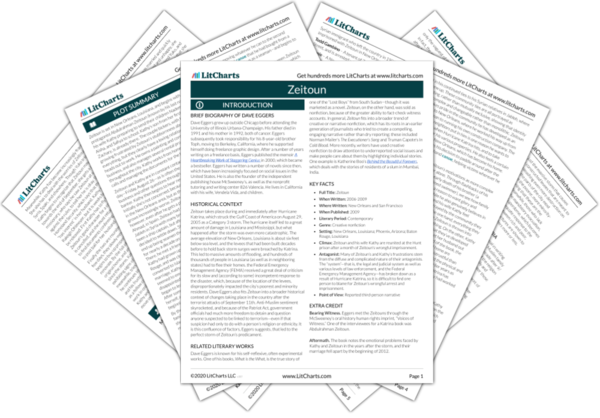With Zeitoun stranded in New Orleans and Kathy in Arizona with their children, two narratives on the fallout from Hurricane Katrina unfold. One, which Kathy hears largely from the media, is that Katrina has turned the city into a war zone, with stealing, shooting, and other illegal activity quickly becoming the norm. This sense of emergency creates a disconnect with her husband’s experience, at least initially: while he sees sporadic examples of looting, the days after the storm are much more defined by a vulnerable, desperate population seeking help or escape. Again and again, Zeitoun asks for help from among the police force, which has been highly militarized and is patrolling neighborhoods in military-style combat gear. He is almost always rebuffed, as it seems that they are there not to find people in need of assistance, but instead to “keep order” against only the vaguest of threats.
In fact, the entire legal and justice system seems to break down after Katrina, as Zeitoun is taken from prison to prison, refused a phone call, and held without bail and without being charged for a crime. A makeshift jail—Camp Greyhound—is quickly built and filled with supplies for the guards and employees, while a few miles away, the Superdome, which is packed with New Orleans residents, has nowhere near the same level of resources.
According to Eggers, the authorities’ post-Katrina emphasis on combating crime and lawlessness served not to uphold justice, but in fact to create injustice—a position that, the book argues, has much to do with the race and ethnicity of those who most needed help.
Crime, Justice, and Injustice ThemeTracker

Crime, Justice, and Injustice Quotes in Zeitoun
When Zeitoun and the others entered the main room of the station, immediately fifty pairs of eyes, those of soldiers and police officers and military personnel, were upon them. There were no other civilians inside. It was as if the entire operation, this bus station-turned-military base, had been arranged for them.
Until this point, Zeitoun had not been charged with a crime. He had not been read his rights. He did not know why he was being held. Now he was in a small white room being asked by two soldiers, each of them in full camouflage and holding automatic rifles, to remove his clothes.
Who did this work? Were there contractors and laborers working around the clock on a prison days after the hurricane? It was mind-boggling. It was all the more remarkable given that while the construction was taking place, on September 2, 3, and 4, thousands of residents were being plucked from rooftops, were being discovered alive and dead in attics.
The ban on phone calls was, then, purely punitive, just as the pepper-spraying of the child-man had been born of a combination of opportunity, cruelty, ambivalence, and sport. There was no utility in that, just as there was no utility in barring all prisoners from contacting the outside world.
He had long believed that the police acted in the best interests of the citizens they served. That the military was accountable, reasonable, and was kept in check by concentric circles of regulations, laws, common sense, common decency. But now those hopes could be put to rest.
He thought of bycatch. It was a fishing term. They’d used it when he was a boy, fishing for sardines by the light of the moon they’d made. When they pulled in the net, there were thousands of sardines, of course, but there were other creatures too, life they had not intended to catch and for which they had no use. Often they would not know until too late.
He had risked too much in the hopes that he might do something to match the deeds of his brother Mohammed. No, it had never been a conscious part of his motivation—he had done what he could in the drowned city because he was there, it needed to be done, and he could do it. But somewhere in his gut, was there not some hope that he, too, could bring pride to the family, as Mohammed had so many years ago? […] And was this imprisonment God’s way of curbing his pride, tempering his vainglorious dreams?
Kathy fell apart. She wailed and screamed. Somehow this, knowing that her husband was so close but that these layers of bureaucracy and incompetence were keeping her from him—it was too much. She cried out of frustration and rage. She felt like she was watching a baby drown, unable to do anything to save it.
They held each other for a long moment. She could feel his shoulder blades, his ribs. His neck seemed so thin and fragile, his arms skeletal. She pulled back, and his eyes were the same—green, long-lashed, touched with honey—but they were tired, defeated. She had never seen this in him. He had been broken.
Gonzalez talked about how the system is supposed to work: police officers investigate, make arrests, and then hand the process over to the judicial system. Under normal circumstances, if the men were innocent, he maintained, they would have been given a phone call and the opportunity to post bail. “They should have gotten a phone call,” he said.
On the one hand, knowing that these two police officers had not purposely hunted and arrested a man because he was Middle Eastern gave them some comfort. But knowing that Zeitoun’s ordeal was caused instead by systemic ignorance and malfunction—and perhaps long-festering paranoia on the part of the National Guard and whatever other agencies were involved—was unsettling. It said, quite clearly, that this wasn’t a case of a bad apple or two in the barrel. The barrel itself was rotten.
To dial a number given to you by a man in a cage, to tell the voice on the other end, “I saw him.” Is that complicated? Is that an act of great heroism in the United States of America? It should not be so.
















